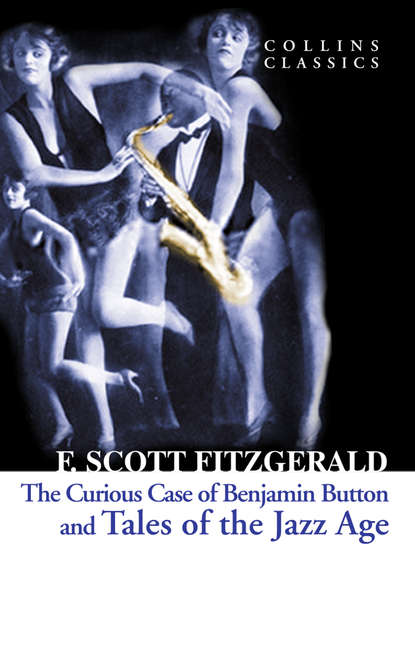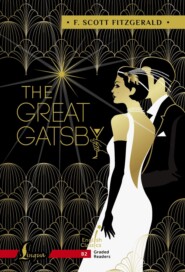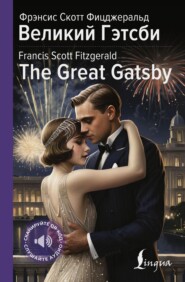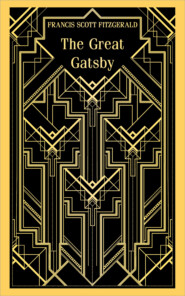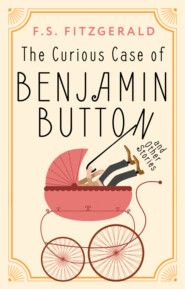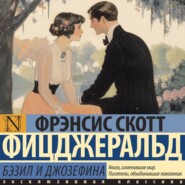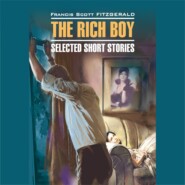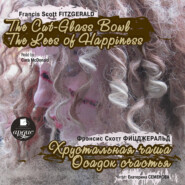По всем вопросам обращайтесь на: info@litportal.ru
(©) 2003-2025.
✖
Tales of the Jazz Age
Год написания книги
2019
Настройки чтения
Размер шрифта
Высота строк
Поля
Tales of the Jazz Age
Francis Scott Key Fitzgerald
HarperCollins is proud to present its incredible range of best-loved, essential classics.In these eleven stories, Fitzgerald depicts the Roaring Twenties as he lived them. He masterfully blends accounts of flappers and the smart set with more fantastical visions of America, always imbuing his narratives with his trademark themes of money, class, ambition and love.In ‘May Day’, Fitzgerald weaves an account of a raucous Yale alumni party, the participants of which are oblivious to the violent socialist demonstration being acted out around them. ‘The Curious Case of Benjamin Button’ is an unorthodox account of a man who ages backwards, and ‘The Diamond as Big as the Ritz’ tells the story of a young man who discovers that his friend’s family possesses a diamond that is literally larger than the Ritz-Carlton Hotel.This 1922 collection confirmed Fitzgerald as the voice of his generation.
TALES OF THE JAZZ AGE
F. Scott Fitzgerald
History of Collins
In 1819, millworker William Collins from Glasgow, Scotland, set up a company for printing and publishing pamphlets, sermons, hymn books, and prayer books. That company was Collins and was to mark the birth of HarperCollins Publishers as we know it today. The long tradition of Collins dictionary publishing can be traced back to the first dictionary William published in 1824, Greek and English Lexicon. Indeed, from 1840 onwards, he began to produce illustrated dictionaries and even obtained a licence to print and publish the Bible.
Soon after, William published the first Collins novel, Ready Reckoner; however, it was the time of the Long Depression, where harvests were poor, prices were high, potato crops had failed, and violence was erupting in Europe. As a result, many factories across the country were forced to close down and William chose to retire in 1846, partly due to the hardships he was facing.
Aged 30, William’s son, William II, took over the business. A keen humanitarian with a warm heart and a generous spirit, William II was truly “Victorian” in his outlook. He introduced new, up-to-date steam presses and published affordable editions of Shakespeare’s works and The Pilgrim’s Progress, making them available to the masses for the first time. A new demand for educational books meant that success came with the publication of travel books, scientific books, encyclopedias, and dictionaries. This demand to be educated led to the later publication of atlases, and Collins also held the monopoly on scripture writing at the time.
In the 1860s Collins began to expand and diversify and the idea of “books for the millions” was developed. Affordable editions of classical literature were published, and in 1903 Collins introduced 10 titles in their Collins Handy Illustrated Pocket Novels. These proved so popular that a few years later this had increased to an output of 50 volumes, selling nearly half a million in their year of publication. In the same year, The Everyman’s Library was also instituted, with the idea of publishing an affordable library of the most important classical works, biographies, religious and philosophical treatments, plays, poems, travel, and adventure. This series eclipsed all competition at the time, and the introduction of paperback books in the 1950s helped to open that market and marked a high point in the industry.
HarperCollins is and has always been a champion of the classics, and the current Collins Classics series follows in this tradition—publishing classical literature that is affordable and available to all. Beautifully packaged, highly collectible, and intended to be reread and enjoyed at every opportunity.
Life & Times
The Jazz Age
There can be few novels as divisive as F. Scott Fitzgerald’s The Great Gatsby in terms of people’s opinion of its literary worth. It registered disappointing sales upon its publication in 1925, which led to Fitzgerald slipping into obscurity despite his having established a reasonable reputation with earlier books. Following his death, in 1940, the book was included on a list of titles to be provided free to U.S. service men and women fighting in World War II. This meant that 150,000 copies began circulating through the armed forces until the book became familiar to overseas Americans. As a result, it had inadvertently worked its way into the American psyche and won favor where otherwise it would have been forgotten.
The story itself is essentially about the moral decay that ensued in America during the 1920s. Although other countries had class divisions, the U.S. had the equivalent of an upper class in the form of patricians, or members of long-established wealthy families. These New World aristocrats lorded themselves over other people and spent much of their lives partying their way through the “Jazz Age.” In addition, 1920 had seen the prohibition of alcohol, with the result that organized criminals found a way to make good money by bootlegging, or illegally selling liquor. When both of these groups came together, they formed a social order of dilettantism—people who assumed and cultivated pretensions of sophistication. The story of The Great Gatsby spirals into tragedy as the book progresses with a succession of events—manslaughter, murder, and then suicide; tragedy that seems all the more horrific in contrast to the spirited and frothy excesses that have come before.
There is more to the popularity of the novel than its installation into the favor of the U.S. literati by proxy—it’s a book that is representative of an era. In truth, most people had little or no direct involvement with the kinds of people described in the book, but it was a subculture that was perceived as glamorous so it caught the public imagination. In the same way that the 1960s only really happened in the heart of Western cities, so the 1920s only really happened in affluent mansions and areas of the U.S. In fact, it was this collision of subcultures, the wealthy and excessive nature of the elite set against the “average Joe,” that gave the book its potency. In Fitzgerald’s book, Myrtle, the wife of a lowly garage owner, gets seduced by the dilettante lifestyle and starts an affair with the monied Tom Buchanan, leading to tragedy for both her and her husband.
The Great Gatsby appeals because the reader enjoys voyeuristically peering in to view the lives of those who are ridiculed as being exotic, foolish, and beguiled and is grateful not to be a part of it. There is a moral judgment involved in the process of reading such a story, and Fitzgerald’s work can be compared to that of the British author Thomas Hardy, who takes the same view that people tend to get what they deserve in life and that the real victims are those who get caught up, either by accident or by attraction. In effect, The Great Gatsby is a Hardy-esque novel set in 1920s America as opposed to 19th-century England. There is a definite register of contempt penned by both of these authors, as if to suggest that they have chosen to point the spotlight at those for whom they have little time in real life.
From a historical perspective, the book tells of a bygone age that is part of U.S. history. Prohibition ended in 1933 when the U.S. government realized the irony of the situation. Christian values had led to prohibition in an attempt to sober up society and generate a more virtuous American nation. In reality, people simply made their own moonshine or else bought their illegal alcohol from speakeasies, thereby making felons wealthy enough to control the police. Bribery and corruption were rife, so the conservatives had to concede that prohibition had countered their intuition. Six years later and World War II began, reshuffling priorities and making the United States a wealthy superpower. In the post-war era, America flourished and prospered. It had been unscathed by the war, and many nations had to borrow its money to rebuild their infrastructures.
The Great Gatsby became a curious window into a world that had been and gone—a world where elements of U.S. society had drowned themselves in a moral and ethical sump. It was a warning about what can happen when people become decadent and dishonorable. The novel served as an antithesis to the values and image that clean-cut Americans wanted to promote in the 1950s, as a new generation became the custodians of their proud nation. Iniquity was brushed under the carpet and only allowed to exist in the land of fiction.
Earlier Works
Fitzgerald wrote a number of short stories, which were packed in a single volume entitled Tales of the Jazz Age (1922). The best-known of these shorts is The Curious Case of Benjamin Button, in which the eponymous central character ages in reverse. He is born old and decrepit and then goes through all of the other stages of life until he eventually dies as a newborn baby. What makes the tale most interesting is the juxtaposition between Benjamin and the people with whom he has relationships, because his life is being carried out in the opposite direction to theirs.
A similar device is used in Martin Amis’ Time’s Arrow (1991), except that the whole world is played backward, so that curious concepts are explored, such as doctors causing injuries, instead of healing them. Also, the reader eventually realizes that the central character is an erstwhile Holocaust doctor when his reverse life takes him to a younger age. Of course, this concept of playing with time was first investigated by H. G. Wells in his novel The Time Machine (1895). In this story Wells has the central character existing in real time, but the machine enables him to travel both forward and backward in time.
There are ten other shorts in Tales of the Jazz Age. Some examine the human characteristics that made the Jazz Age what it was, such as the excess, frivolity, vanity, pretensions, and cultural hysteria brought about by the mood following World War I.
Just as the Restoration in England generated a kind of lighthearted optimism after the suppressive atmosphere under the Puritans, so the Jazz Age was a kind of celebration of life after so much death in Europe. It was marked by the popularity of jazz music and an associated dance craze, but would all come to an end in the early1930s with the Great Depression.
Exploring the topic of excess in this collection is the tale A Diamond as Big as the Ritz. In this story, Fitzgerald gives the central character a dilemma to solve. In his quest to become rich, Percy Washington discovers a mountain comprising a single diamond, but he realizes that if he saturates the market with diamonds, they will become commonplace and have no value. Both stories highlight Fitzgerald’s underlying inclination to experiment with intellectual and philosophical concepts in his work. This is largely why he is regarded as a literary writer, rather than merely a teller of tales.
On face value, much of his writing would seem to be amusing comment on his own “Smart Set” lifestyle and aimed at others from the same milieu, but Fitzgerald was an intelligent man with considerable depth to his thinking. It is just that he also knew how to be commercial enough to make money from his writing, which demanded a layer of gloss and polish. His was a world of inherited privilege, inhabited by pseudo-intellectuals and posers. He himself made several trips to Paris and the French Riviera, where he cultivated and honed a lifestyle that went hand in hand with his writing style. He wrote about what he knew, but he injected other elements to facilitate his curiosity about the human condition and give his writing greater literary weight.
Fitzgerald and Hemingway
Fitzgerald was friends with arguably the greatest American writer, Ernest Hemingway. Hemingway encouraged Fitzgerald to pursue his prose with artistic integrity, but grew frustrated with Fitzgerald’s tendency toward making his literature commercial. However, most of Fitzgerald’s novels did not perform that well, so a large part of his income came from magazine work, writing short stories that, by their very nature, had to conform to editorial requirements. Nine years after The Great Gatsby, he had struggled to complete his final novel Tender Is The Night. Unfortunately for Fitzgerald, the book was received with disappointment, and the decline of his writing career continued unabated. In the latter half of the 1930s, he found work developing movie scripts and carried out further commercial writing. By the time of his death, his literary career had died, too.
In hindsight, Fitzgerald’s work is regarded variously, but The Great Gatsby has become the quintessential American classic. Some feel that Fitzgerald’s talent would have been better focused on his novel writing, but fiscal matters always dictated that he continue with his commercial work. However, Hemingway may have been a heavyweight writer but he was certainly not a contented man. For him the praise he garnered for each new book was a fix. When he ran out of ideas, he suffered severe depression and ultimately took his own life with a shotgun. Fitzgerald battled on in a workmanlike manner even when plaudits were a distant memory. Fitzgerald the legendary writer has now outlived Fitzgerald the man several times over.
CONTENTS
Title Page (#udb5c8a61-8356-50f5-9b5f-180e041f9c16)
History of Collins (#u841aba69-3dba-5305-ad65-7d4a695af7e6)
Life & Times (#ucc4d2af7-0b8f-5826-8a26-d9b7771828dc)
My Last Flappers (#u43845943-8aeb-542a-b3ac-2f425df281f6)
The Jelly-Bean (#u58b9e80a-d4fe-5784-bffd-1e4a6e914341)
The Camel’s Back (#uf3a40f6b-da0c-5d29-a315-4dc967e62f1e)
May Day (#ub1bb5c9c-5703-5a52-b511-89cea2f5c3a2)
Porcelain and Pink (#litres_trial_promo)
Fantasies (#litres_trial_promo)
The Diamond as Big as the Ritz (#litres_trial_promo)
The Curious Case of Benjamin Button (#litres_trial_promo)
Tarquin of Cheapside (#litres_trial_promo)
“O Russet Witch!” (#litres_trial_promo)
Unclassified Masterpieces (#litres_trial_promo)
The Lees of Happiness (#litres_trial_promo)
Mr. Icky (#litres_trial_promo)
Jemina, The Mountain Girl (#litres_trial_promo)
Classic Literature: Words and Phrases adapted from the Collins English Dictionary (#litres_trial_promo)
Copyright (#litres_trial_promo)
About the Publisher (#litres_trial_promo)
MY LAST FLAPPERS
Francis Scott Key Fitzgerald
HarperCollins is proud to present its incredible range of best-loved, essential classics.In these eleven stories, Fitzgerald depicts the Roaring Twenties as he lived them. He masterfully blends accounts of flappers and the smart set with more fantastical visions of America, always imbuing his narratives with his trademark themes of money, class, ambition and love.In ‘May Day’, Fitzgerald weaves an account of a raucous Yale alumni party, the participants of which are oblivious to the violent socialist demonstration being acted out around them. ‘The Curious Case of Benjamin Button’ is an unorthodox account of a man who ages backwards, and ‘The Diamond as Big as the Ritz’ tells the story of a young man who discovers that his friend’s family possesses a diamond that is literally larger than the Ritz-Carlton Hotel.This 1922 collection confirmed Fitzgerald as the voice of his generation.
TALES OF THE JAZZ AGE
F. Scott Fitzgerald
History of Collins
In 1819, millworker William Collins from Glasgow, Scotland, set up a company for printing and publishing pamphlets, sermons, hymn books, and prayer books. That company was Collins and was to mark the birth of HarperCollins Publishers as we know it today. The long tradition of Collins dictionary publishing can be traced back to the first dictionary William published in 1824, Greek and English Lexicon. Indeed, from 1840 onwards, he began to produce illustrated dictionaries and even obtained a licence to print and publish the Bible.
Soon after, William published the first Collins novel, Ready Reckoner; however, it was the time of the Long Depression, where harvests were poor, prices were high, potato crops had failed, and violence was erupting in Europe. As a result, many factories across the country were forced to close down and William chose to retire in 1846, partly due to the hardships he was facing.
Aged 30, William’s son, William II, took over the business. A keen humanitarian with a warm heart and a generous spirit, William II was truly “Victorian” in his outlook. He introduced new, up-to-date steam presses and published affordable editions of Shakespeare’s works and The Pilgrim’s Progress, making them available to the masses for the first time. A new demand for educational books meant that success came with the publication of travel books, scientific books, encyclopedias, and dictionaries. This demand to be educated led to the later publication of atlases, and Collins also held the monopoly on scripture writing at the time.
In the 1860s Collins began to expand and diversify and the idea of “books for the millions” was developed. Affordable editions of classical literature were published, and in 1903 Collins introduced 10 titles in their Collins Handy Illustrated Pocket Novels. These proved so popular that a few years later this had increased to an output of 50 volumes, selling nearly half a million in their year of publication. In the same year, The Everyman’s Library was also instituted, with the idea of publishing an affordable library of the most important classical works, biographies, religious and philosophical treatments, plays, poems, travel, and adventure. This series eclipsed all competition at the time, and the introduction of paperback books in the 1950s helped to open that market and marked a high point in the industry.
HarperCollins is and has always been a champion of the classics, and the current Collins Classics series follows in this tradition—publishing classical literature that is affordable and available to all. Beautifully packaged, highly collectible, and intended to be reread and enjoyed at every opportunity.
Life & Times
The Jazz Age
There can be few novels as divisive as F. Scott Fitzgerald’s The Great Gatsby in terms of people’s opinion of its literary worth. It registered disappointing sales upon its publication in 1925, which led to Fitzgerald slipping into obscurity despite his having established a reasonable reputation with earlier books. Following his death, in 1940, the book was included on a list of titles to be provided free to U.S. service men and women fighting in World War II. This meant that 150,000 copies began circulating through the armed forces until the book became familiar to overseas Americans. As a result, it had inadvertently worked its way into the American psyche and won favor where otherwise it would have been forgotten.
The story itself is essentially about the moral decay that ensued in America during the 1920s. Although other countries had class divisions, the U.S. had the equivalent of an upper class in the form of patricians, or members of long-established wealthy families. These New World aristocrats lorded themselves over other people and spent much of their lives partying their way through the “Jazz Age.” In addition, 1920 had seen the prohibition of alcohol, with the result that organized criminals found a way to make good money by bootlegging, or illegally selling liquor. When both of these groups came together, they formed a social order of dilettantism—people who assumed and cultivated pretensions of sophistication. The story of The Great Gatsby spirals into tragedy as the book progresses with a succession of events—manslaughter, murder, and then suicide; tragedy that seems all the more horrific in contrast to the spirited and frothy excesses that have come before.
There is more to the popularity of the novel than its installation into the favor of the U.S. literati by proxy—it’s a book that is representative of an era. In truth, most people had little or no direct involvement with the kinds of people described in the book, but it was a subculture that was perceived as glamorous so it caught the public imagination. In the same way that the 1960s only really happened in the heart of Western cities, so the 1920s only really happened in affluent mansions and areas of the U.S. In fact, it was this collision of subcultures, the wealthy and excessive nature of the elite set against the “average Joe,” that gave the book its potency. In Fitzgerald’s book, Myrtle, the wife of a lowly garage owner, gets seduced by the dilettante lifestyle and starts an affair with the monied Tom Buchanan, leading to tragedy for both her and her husband.
The Great Gatsby appeals because the reader enjoys voyeuristically peering in to view the lives of those who are ridiculed as being exotic, foolish, and beguiled and is grateful not to be a part of it. There is a moral judgment involved in the process of reading such a story, and Fitzgerald’s work can be compared to that of the British author Thomas Hardy, who takes the same view that people tend to get what they deserve in life and that the real victims are those who get caught up, either by accident or by attraction. In effect, The Great Gatsby is a Hardy-esque novel set in 1920s America as opposed to 19th-century England. There is a definite register of contempt penned by both of these authors, as if to suggest that they have chosen to point the spotlight at those for whom they have little time in real life.
From a historical perspective, the book tells of a bygone age that is part of U.S. history. Prohibition ended in 1933 when the U.S. government realized the irony of the situation. Christian values had led to prohibition in an attempt to sober up society and generate a more virtuous American nation. In reality, people simply made their own moonshine or else bought their illegal alcohol from speakeasies, thereby making felons wealthy enough to control the police. Bribery and corruption were rife, so the conservatives had to concede that prohibition had countered their intuition. Six years later and World War II began, reshuffling priorities and making the United States a wealthy superpower. In the post-war era, America flourished and prospered. It had been unscathed by the war, and many nations had to borrow its money to rebuild their infrastructures.
The Great Gatsby became a curious window into a world that had been and gone—a world where elements of U.S. society had drowned themselves in a moral and ethical sump. It was a warning about what can happen when people become decadent and dishonorable. The novel served as an antithesis to the values and image that clean-cut Americans wanted to promote in the 1950s, as a new generation became the custodians of their proud nation. Iniquity was brushed under the carpet and only allowed to exist in the land of fiction.
Earlier Works
Fitzgerald wrote a number of short stories, which were packed in a single volume entitled Tales of the Jazz Age (1922). The best-known of these shorts is The Curious Case of Benjamin Button, in which the eponymous central character ages in reverse. He is born old and decrepit and then goes through all of the other stages of life until he eventually dies as a newborn baby. What makes the tale most interesting is the juxtaposition between Benjamin and the people with whom he has relationships, because his life is being carried out in the opposite direction to theirs.
A similar device is used in Martin Amis’ Time’s Arrow (1991), except that the whole world is played backward, so that curious concepts are explored, such as doctors causing injuries, instead of healing them. Also, the reader eventually realizes that the central character is an erstwhile Holocaust doctor when his reverse life takes him to a younger age. Of course, this concept of playing with time was first investigated by H. G. Wells in his novel The Time Machine (1895). In this story Wells has the central character existing in real time, but the machine enables him to travel both forward and backward in time.
There are ten other shorts in Tales of the Jazz Age. Some examine the human characteristics that made the Jazz Age what it was, such as the excess, frivolity, vanity, pretensions, and cultural hysteria brought about by the mood following World War I.
Just as the Restoration in England generated a kind of lighthearted optimism after the suppressive atmosphere under the Puritans, so the Jazz Age was a kind of celebration of life after so much death in Europe. It was marked by the popularity of jazz music and an associated dance craze, but would all come to an end in the early1930s with the Great Depression.
Exploring the topic of excess in this collection is the tale A Diamond as Big as the Ritz. In this story, Fitzgerald gives the central character a dilemma to solve. In his quest to become rich, Percy Washington discovers a mountain comprising a single diamond, but he realizes that if he saturates the market with diamonds, they will become commonplace and have no value. Both stories highlight Fitzgerald’s underlying inclination to experiment with intellectual and philosophical concepts in his work. This is largely why he is regarded as a literary writer, rather than merely a teller of tales.
On face value, much of his writing would seem to be amusing comment on his own “Smart Set” lifestyle and aimed at others from the same milieu, but Fitzgerald was an intelligent man with considerable depth to his thinking. It is just that he also knew how to be commercial enough to make money from his writing, which demanded a layer of gloss and polish. His was a world of inherited privilege, inhabited by pseudo-intellectuals and posers. He himself made several trips to Paris and the French Riviera, where he cultivated and honed a lifestyle that went hand in hand with his writing style. He wrote about what he knew, but he injected other elements to facilitate his curiosity about the human condition and give his writing greater literary weight.
Fitzgerald and Hemingway
Fitzgerald was friends with arguably the greatest American writer, Ernest Hemingway. Hemingway encouraged Fitzgerald to pursue his prose with artistic integrity, but grew frustrated with Fitzgerald’s tendency toward making his literature commercial. However, most of Fitzgerald’s novels did not perform that well, so a large part of his income came from magazine work, writing short stories that, by their very nature, had to conform to editorial requirements. Nine years after The Great Gatsby, he had struggled to complete his final novel Tender Is The Night. Unfortunately for Fitzgerald, the book was received with disappointment, and the decline of his writing career continued unabated. In the latter half of the 1930s, he found work developing movie scripts and carried out further commercial writing. By the time of his death, his literary career had died, too.
In hindsight, Fitzgerald’s work is regarded variously, but The Great Gatsby has become the quintessential American classic. Some feel that Fitzgerald’s talent would have been better focused on his novel writing, but fiscal matters always dictated that he continue with his commercial work. However, Hemingway may have been a heavyweight writer but he was certainly not a contented man. For him the praise he garnered for each new book was a fix. When he ran out of ideas, he suffered severe depression and ultimately took his own life with a shotgun. Fitzgerald battled on in a workmanlike manner even when plaudits were a distant memory. Fitzgerald the legendary writer has now outlived Fitzgerald the man several times over.
CONTENTS
Title Page (#udb5c8a61-8356-50f5-9b5f-180e041f9c16)
History of Collins (#u841aba69-3dba-5305-ad65-7d4a695af7e6)
Life & Times (#ucc4d2af7-0b8f-5826-8a26-d9b7771828dc)
My Last Flappers (#u43845943-8aeb-542a-b3ac-2f425df281f6)
The Jelly-Bean (#u58b9e80a-d4fe-5784-bffd-1e4a6e914341)
The Camel’s Back (#uf3a40f6b-da0c-5d29-a315-4dc967e62f1e)
May Day (#ub1bb5c9c-5703-5a52-b511-89cea2f5c3a2)
Porcelain and Pink (#litres_trial_promo)
Fantasies (#litres_trial_promo)
The Diamond as Big as the Ritz (#litres_trial_promo)
The Curious Case of Benjamin Button (#litres_trial_promo)
Tarquin of Cheapside (#litres_trial_promo)
“O Russet Witch!” (#litres_trial_promo)
Unclassified Masterpieces (#litres_trial_promo)
The Lees of Happiness (#litres_trial_promo)
Mr. Icky (#litres_trial_promo)
Jemina, The Mountain Girl (#litres_trial_promo)
Classic Literature: Words and Phrases adapted from the Collins English Dictionary (#litres_trial_promo)
Copyright (#litres_trial_promo)
About the Publisher (#litres_trial_promo)
MY LAST FLAPPERS





